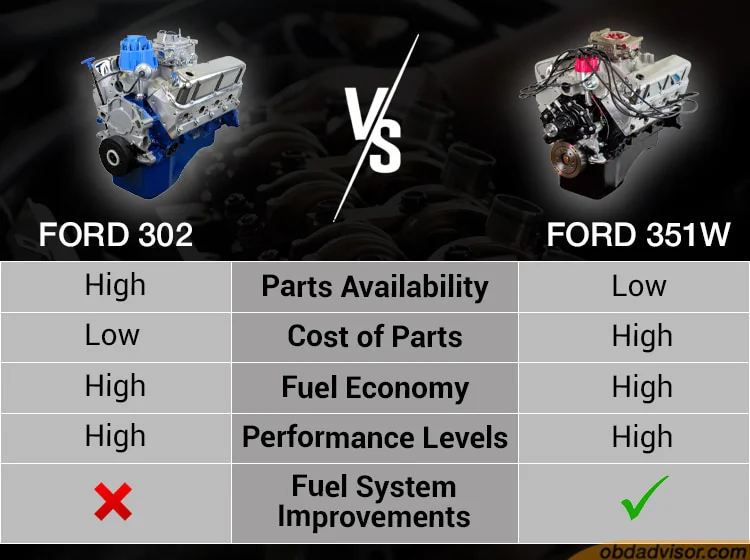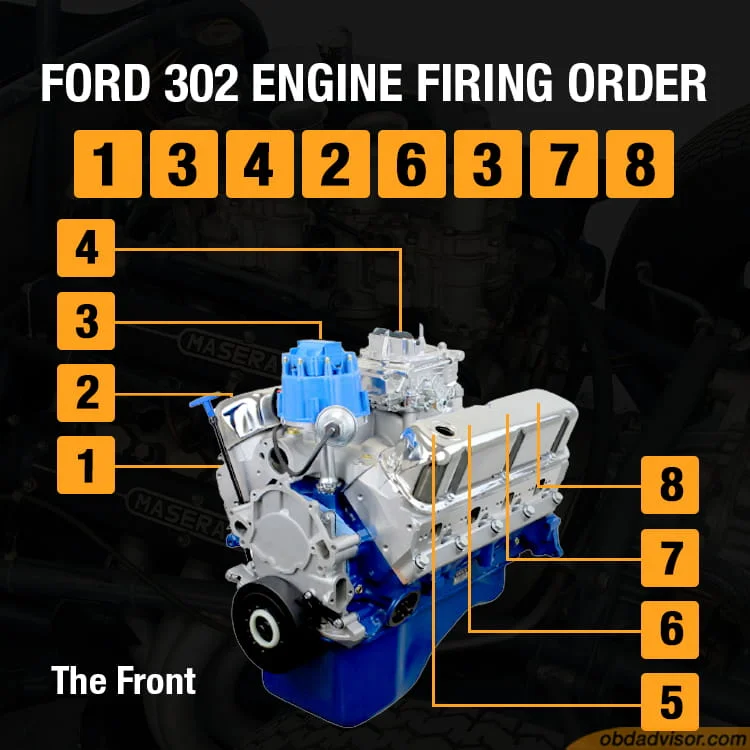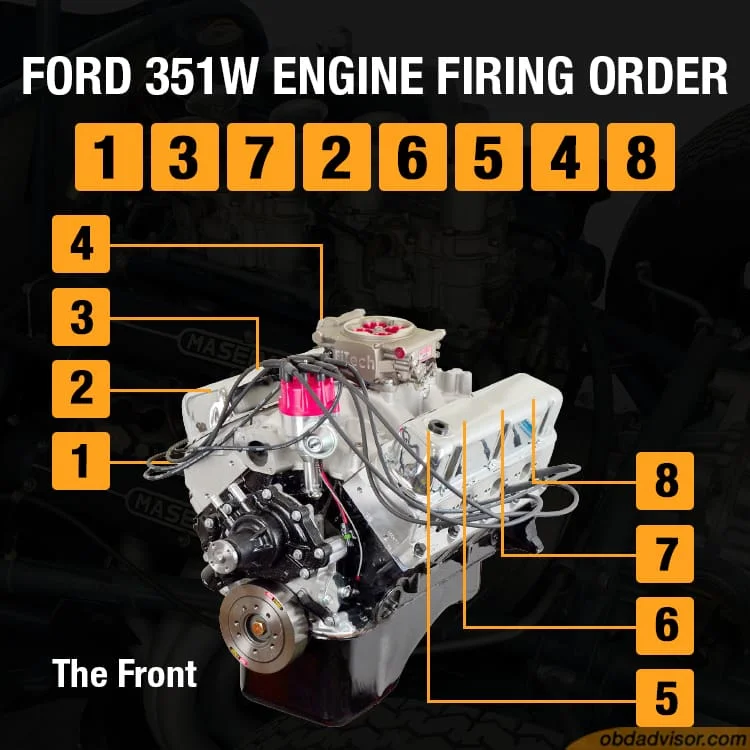If you want a vehicle to serve you well, one aspect of the car you have to pay close attention to is the engine. Vehicle owners who prefer Ford engines have a lot of great options to choose from. The Ford 302 vs. 351W is an argument auto experts have often. Naturally, you want to pick the best one for you.
These two engines have their perks, and for many, opinions fall on both ends of the spectrum. With opinions so widely split, the best way to make a decision is to have a side-by-side analysis of both engines.
When you know each engine’s performance stats and specifications, you can better determine which one suits your needs. So, here’s a comprehensive analysis of the 302 and the 351W.
Overview
When it comes to Ford engines, you have a variety of choices. There’s the 289, 302, and 351 engine, to mention a few. These are V-8 small-block engines that are highly notable for their formidable power and performance levels. Of these three engines, the most popular ones are the 302 and 351 cubic-inch engines.
On the surface, both engines don’t appear to be very different. The compression ratios for both engines differ based on the year of production. However, there are a few distinctions in terms of their performance specifics. Knowing what these differences are in detail and how they are relevant can help you make a more informed decision.
The 302 is most notably used as the 5.0 engine in Ford’s Shelby GTs. With a bore of 4.0 inches, this engine has powered everything from Ford to Lincoln and Mercury vehicles. The 302 was manufactured from 1968 to 1995. It comes in three versions; the two-barrel, four-barrel engine, and high-performance engine. These engines generate 210, 235 and 235 horsepower, respectively.
Produced from 1969 to 1974, the 351W also has a 4.0-inch bore. It also boasts large valves, heads and has a heavy block. Its two-barrel and four-barrel versions produce 250 and 290 horsepower, respectively. When pushed to the limit, its high-performance versions generate up to 300 horsepower.
To find out which engine is superior, you must analyze the engines side-by-side to see what they have in store for you.
Ford 302 vs. 351W Engine specifications
While the 302 and 351 Windsor engines are both created with a 4.0-inch bore, that is basically where their similarities end. The stroke of the former is measured at 3.0 inches, while the latter is 3.5 inches.
Another factor that clearly distinguishes both engines is the nature and structure of their build. The main bearing caps of the 351W are much stronger than those of the 302. In the same vein, the connecting rods of the 351W are also larger. One reason for the shorter rods seen in the 302 is that they can replace the 289 engine if the need arises.
These two engines are also very different in terms of the power they can produce. The maximum power that a typical 302 can generate is about 235 horsepower at 4,800 rpm. For high-performing 351W engines, you can get up to 300 horsepower at 5,400 rpm.
Lastly, the standard 302 engine supports about 377-foot pounds of torque, while the 351W engine totals about 352-foot pounds.
| Specifications | 302 | 351W |
| Bore | 4.0 Inches | 4.0 Inches |
| Stroke | 3.0 Inches | 3.5 Inches |
| 2-Barrel Version Output | 210 Horsepower | 250 Horsepower |
| 4-Barrel Version Output | 235 Horsepower | 290 Horsepower |
| High-Performance Version Output | 235 Horsepower | 300 Horsepower |
| RPM | 4800 | 5400 |
| Torque | 377 | 352 |
| Deck Height | 8.201 – 8.210 Inches | 9.480 – 9.503 Inches |
Other differences

Outside the disparities in their performance stats, there are a few other things you should also look at when picking the perfect engine. Even authentic machines will break down at one point. The ability to make all necessary repairs without stress is crucial.
To help inform that decision, here is a comparison of various features of these engines.
Affordability and accessibility of parts
On average, the parts of a 302 tend to be easier to find than those of the 351W. More than this, many people prefer upgrading to a 302 engine because they are also cheaper. The cost of building a 302 from scratch may differ, depending on whether you want a Boss 302 or a 302 Windsor. Still, you aren’t expected to spend over $5,000.
However, for 351W engines, you will have to spend a bit more, depending on how willing you are to reuse certain parts and if you’ll be getting any professional assistance with the assembly of the engine.
Interchangeability
If you have an old 302 engine lying around, you can save costs by interchanging some of its working parts with that of your new 351W, and vice versa! For instance, some parts of a 351 you can fit in a 302 include the;
- Front covers
- Timing chains
- Motor mounts
- Exhaust manifolds
- Valve train parts and the cylinder heads (except for the pushrods)
You can also switch the camshafts. However, you would need to adjust the firing order of the 351W to get it working perfectly with the 302 engine.
Fuel economy
A lot of factors influence the fuel efficiency you can expect from either of these engines. First, you should know that there’s a difference in their capacity. A 302 engine has a capacity of 4.9L, while the 351W has a total of 5.8L. However, all things considered, the 302 is marginally more fuel efficient than the 351W.
Performance levels
The 302 is a capable engine. Although its highest-performing variants have a maximum power output of 235 horsepower, you can still get more out of it. If you’re willing to upgrade parts like the headers and rockers, you can push this to 402 horsepower. People who choose to upgrade the engine from top to bottom can get as high as 479 horsepower.
The fuel system upgrades that the 351W got in 1997 is one variable that contributes to the outstanding performance you can get out of it today. It has aged quite well and also boasts an exceptional lifespan.
Firing order
The firing order of an engine is what determines the level of power it can generate. This is also critical to the smooth running of the system and contributes to the engine’s longevity. Lastly, the firing order is what influences the number of unwanted vibrations you experience. It is for this reason that you should know what firing order to expect from these two engines.
302 firing order

The firing order of this engine is 1-5-4-2-6-3-7-8, where the number 1 cylinder is on the right bank, nearest to the vehicle’s radiator. The rotor direction of the engine under the distributor moves counterclockwise.
As a rule, Ford numbers the cylinders in their engine from the front to the back in a sequence.
351W firing order

The firing order for this type of engine is 1-3-7-2-6-5-4-8. While it is possible to use 1-5-4-2-6-3-7-8 order here as well, the result you’ll get will leave a lot to be desired. Also, mixing these firing orders might harm drivability.
The Ford 302 H.O has the same firing order of the 351W.
Conclusion
Faced with the decision to use a 302 or 351W engine, choosing can be difficult. These engines are more or less even in terms of fuel efficiency and durability. However, there is a distinct difference where affordability and power is concerned. The 302 is the engine to choose if you want a reasonably priced machine. The 351W is more expensive but affords you more power.
So, it ultimately comes down to your preferences and what you prioritize. Still, both the 302 and the 351W are high-quality devices that offer good value for money. So, an investment in either wouldn’t be misplaced.
Read more: Best Ford OBD1 OBD2 scan tool 2021: Never buy it before reading this guide